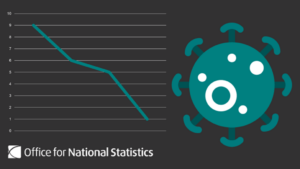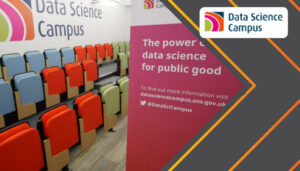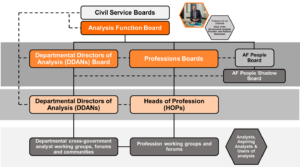Analysis Function Strategy for 2022 to 2025
Our vision
Delivering better outcomes for the public by providing the best analysis to inform decision making.
Foreword from Professor Sir Ian Diamond
I am excited to introduce the Government Analysis Function’s strategy for 2022 to 2025 which sets out the next phase of our journey in ensuring analysis is the best it can be, unlocking its potential, and delivering better outcomes for the public.
Firstly, I want to thank analysts across government for all your hard work and dedication, especially in these recent difficult times, and congratulate you on the world class analysis that has driven decision making and supported government and society in understanding the most important topics and challenges of the day.
Since we published our first strategy for the Analysis Function in 2018, much has changed. The last few years have been transformative for the use and understanding of analysis, both by decision-makers at the heart of government and for the wider public. This strategy sets out our aspirations to build on this and deliver ever more innovative and impactful analysis that changes society for the better.
Never has there been a more important time to reach out across our analytical community – and far beyond – to collaborate, share knowledge and seize new opportunities, to ensure that analysis really is the best it can be.
Our strategy sets out an ambitious vision and objectives for the next three years. There is lots for us to do. I am hugely proud to be leading the Analysis Function and I know that, together, we will continue to be a driving force for good – delivering the best possible analysis to inform decision making and deliver better outcomes for the public.
Who are we?
The Analysis Function is here to support everyone working in a role that involves analysis, and together we can achieve our vision.
The Government Analysis Function is a diverse community made up of thousands of analysts across government who deliver the evidence and insights that matter for decision-makers and the public. We bring together a broad range of expertise and talent across the Analysis Function and encompass all people or teams that produce analysis, evidence, and research, including members of seven analytical professions and aspiring analysts. Each profession adds its own analytical value, and the aim of the Analysis Function is to help analysts share good practice and standards across the professions, discover innovative methods and deliver analysis with impact.
Find out more about the members of the Analysis Function.
The Analysis Function was established in 2018, recognising that bringing together the analytical community and the analytical professions as a Function (joining other Functions such as Finance, Human Resources and Project Delivery) has real benefits for promoting a shared vision for analysis across government and greater collaborative working, to ensure that evidence and insight has a real impact on the key challenges facing decision-makers and society today, and in future.
The Function is supported by the Analysis Function central team, which works closely with analysts and our analytical leadership to deliver cross-cutting initiatives that support and build our community and raise our profile, ultimately increasing the impact of analysis and its role in improving outcomes for UK citizens.
Since the Analysis Function was established in 2018, we have continued to evolve. We have brought the analytical community closer together, championed best practice and shone a spotlight on impactful analysis, through initiatives like Analysis in Government Month and our annual Analysis in Government Awards. We have developed and strengthened our learning and development offer to all analysts, including launching the Career Framework and Learning Curriculum. We have collaborated across the centre of government to ensure that robust, open evidence is at the heart of decision-making and that we share with works. Including working in partnership with the Government Office for Science (GO-Science) to implement the Concordat to Support Research Integrity across government, and with the Evaluation Task Force to build capability in evaluation and ensure that policies and spending decisions are informed by a strong evidence base.
We want to build on the progress made in recent years and move to the next stage in this exciting journey.
Our Strategy sets out:
- our vision for analysis in government over the next three years and our ambitions for putting analysis at the heart of decision making
- the priorities for the Function and the cross-cutting areas we want to focus on to support the whole analytical community in achieving this vision
- how the Analysis Function central team will support making this a reality, working in close partnership with analysts, professions, other functions, and the wider community across government
Our vision for analysis in government
Why analysis matters
As analysts, we provide innovative and insightful analysis to drive decision- making and support government and society in understanding the most important topics and challenges of the day. We do so much more than just providing the data and evidence; we work in close partnership with policy and operational colleagues, alongside other functions, to make sure that analysis is at the very heart of what government does and the way it delivers value for citizens.
Analysis has never been so important, and our work is vital to delivering better outcomes for the public in the UK. Analysts across government played a critical role throughout the COVID-19 pandemic and we have seen huge strides forward in pace and innovation, responding to the need for rapid, trusted and joined-up evidence on our changing society. Policy makers – and the wider public – look to the analytical community to deliver the insights that matter and shine a spotlight on all dimensions of the world we live in.
Our journey so far
We have great ambitions for both the role of analysis, and the analytical community across government, over the next three years. As society changes, analysis must change too to ensure we are maximising the impact and value it has on decision making in the UK.
We have a strong foundation from which to build. The Analysis Function has achieved high scores in the Annual Functional Quality Survey, showcasing the real value placed on analysis by our customers across the whole of government. The analytical community has delivered world-leading insights – on economic, social, health and environmental topics – that have had a profound impact on our understanding of the most important questions of the day.
We want to go from strength to strength, forging an even closer and deeper partnership across the analytical community and beyond, to deliver analysis with impact. As the opportunities to bring together even more data expand, we want to be at the forefront of unlocking the power of innovative new techniques and tools to help us answer key questions, fill longstanding evidence gaps, and provide a richer and more responsive evidence base for policymakers and the public.
In short, we want analysis to be the very best it can be. Both for driving policy and operational decision-making at the heart of government, and for delivering real impact and insights for citizens. As we look ahead to the next three years, we look forward to working with partners across and beyond government to deliver just this.
Case studies
A selection of case studies give a flavour of the significant impact that analysis has made in government in recent years.

When the pandemic hit the UK there was no established way of collecting data on COVID-19. Through the collaboration of world class analysts across education and healthcare, the Office for National Statistics developed the COVID-19 Infection Survey (CIS) to estimate the number of people testing positive for COVID-19 across the UK, which thousands of people took part in.
This data was vital in understanding the level of infections, insight into the spread of the virus and how it affects different groups of people, and have been used in many ways, by members of the public supporting positive behaviour change to policy professionals making decisions on health, inequality, economic issues and climate change policies.
The project was a joint winner of the Analysis in Government Award 2020 for Collaboration and features in the “Collaboration in analysis” YouTube video on the Analysis Function channel. This is only one example of the many ways that analysts across government have supported the response to the pandemic.

The Data Science Campus is the UK public sector’s centre of excellence in data science. With a mission to deliver “data science for the public good”, by delivering innovative new data and research and building UK data science capability across the Analysis Function and beyond.
In 2021 the Campus delivered novel indicators on the ‘busy-ness’ of roads in urban areas. Cutting-edge data science techniques were used to tap into 1,500 publicly accessible CCTV camera feeds every ten minutes and turn them into real-time counts of journeys. Armed with these methods, analysts were able to deliver rapid, anonymised data on mobility patterns, information that supported decision-makers during the pandemic and informed the public through the published statistics. The approach is also now being trialled in other countries, showcasing the impact of UK analysis on the international stage.

The GCSE Lifetime Productivity Ready Reckoner revolutionised the way student data is used to indicate performance, by using Longitudinal Educational Outcomes, an administrative dataset that links education, income, and employment records, for every child in the state school system in England.
Collaboration was key to the success of the project; an Academic Advisory Panel was established to test the approach which included world-leading economists from educational establishments across the United Kingdom.
Sparking a change in the use of this extensive data, the GCSE attainment and lifetime earnings report provided the first ever productivity estimates associated with GCSE grades. The project won the John Hoy Memorial Award in 2021 and was Runner Up in the Analysis in Government Awards 2021 for Innovative Methods.

The Department for Transport (DfT) took a novel approach in using previously unused data from mobile network operators and linking with Office for National Statistics (ONS) census information to better understand the impact of coronavirus travel restrictions in near real time.
The resulting dataset formed the basis for a range of analysis and insights (including predictive analytics) to support aggregated mobility monitoring both during and after each lockdown, as well as enabling deep-dives into regional issues, that supported the monitoring and decision making in Government. DfT has continued to use this valuable source of mobility data to support understanding of the impact of rail strikes and the policies to alleviate the HGV driver shortages.
Analysis for the future: our vision for the next three years
To achieve our vision and deliver analysis with impact, we must forge even closer and deeper partnerships across the analytical community and beyond.
As the opportunities to bring together even more data expand, we need to be at the forefront of unlocking the power of analysis through innovative new techniques and tools to help us to lead the agenda to answer key questions, fill longstanding evidence gaps, and provide a richer and more responsive evidence base for policymakers and the public around key matters.
As we look ahead to the next three years, our vision for analysis in government is delivering better outcomes for the public by providing the best analysis to inform decision making. What does success look like? Our ambition is for the Analysis Function to deliver the following outcomes:
- a more consistent standard of what good analysis looks like across government
- a vibrant analytical community across government, spanning departments and professions
- a greater harmonisation in standards and ways of working across government; with influential, joined-up leadership supporting this
- an opportunity for efficiency through economies of scale, reducing duplication and promoting opportunities for transformation and cutting-edge capabilities
- a more skilled, diverse, and widely deployable workforce who can enjoy a broader range of career opportunities
- ensuring analysis has a seat at the most important decision-making tables and leads the agenda in responding to the priorities of the day and the long-term challenges, risks and opportunities of the future
To oversee the work of the Analysis Function, there is a clear governance structure in place that reports up to the Head of the Civil Service.
Our analytical leadership is embedded across government and are responsible for delivering the strategy vision and objectives.

The organisation chart shows the Civil Service Boards and Analysis Function Board at the top. Professor Sir Ian Diamond is Head of Government Analysis Function and National Statistician. Underneath are the Departmental Directors of Analysis (DDANs) Board and Professions Boards. Underneath this are the DDANs and Heads of Profession (HoPs). All these groups and individuals serve the needs of the Analysis Function population, including Departmental cross-government analyst working groups and forums, Profession working groups and forums and all analysts, aspiring analysts and users of analysis.
Each of the seven analytical professions has an overall Head of Profession (HoP).
The Heads of Profession are:
- Fiona Dunsire: Government Actuary, Government Actuary’s Department (GAD)
- Mike Potter: Chief Digital Officer for Government
- Sam Beckett: Head of the Government Economic Service (GES)
- David Wood: Head of Government Geography Profession
- Tony O’Connor: Head of Government Operational Research Service (GORS)
- Jenny Dibden: Head of Government Social Research (GSR) Profession
- Professor Sir Ian Diamond: Head of Government Analysis Function, National Statistician, Head of Government Statistical Service (GSS)
Our Analysis Function governance has steered the development of this strategy, ensuring it reflects the whole analytical system and our collective vision for the future. As part of this, we also heard and took on board views from analysts across professions, grades, and departments. This includes from our AF People Shadow Board, who play a crucial role in bringing diverse voices into our decision-making. This is a path we will continue to build on in future.
What this means for members of the Analysis Function
As part of delivering our vision for the future of analysis in government, the Analysis Function is here to celebrate the fantastic analytical work happening across government – across departments, professions, and existing analytical communities.
The leadership and Analysis Function central team are here to support you, as a member of the Function, to have access to a wide range of products, support and opportunities which can help you in your role and to develop throughout your career. You have many opportunities to network and build connections with a diverse range of analysts across government and share your successes and lessons learned.
Whether you are a junior analyst, an experienced analyst, a senior leader or a policy maker, this strategy will ensure that the Analysis Function is supporting you, to ensure all analysis is the best it can be.
Together, we have a shared set of values for all members across the Analysis Function.
Our values
- We are forward thinking
- We are inclusive
- We are trustworthy
- We are proud
Through upholding these values and delivering this strategy, we will continue to build our community and ensure analysis is the best it can be whilst contributing to a Modern Civil Service with a skilled, innovative and ambitious Civil Service equipped for the future.
Achieving our vision
To achieve our vision and support the whole analytical community in delivering the best possible analysis to inform decision making, we have identified six strategic objectives for the Analysis Function. These objectives take on board the feedback from our members, stakeholders, and users of analysis and:
- are focused on the cross-cutting priorities that will maximise the impact of analysis across government, both now and in the future
- are aligned with the central role and core objectives for all functions across government
- draw on and add value across the analytical professions, building coherence whilst championing the distinct and diverse skills across the analytical community
We will deliver these objectives through a three-year delivery plan, led by the Analysis Function central team, working in partnership with professions, the analytical community, and our stakeholders – with oversight by the leadership of the Function.
To deliver high quality analysis it is fundamental that support, guidance, and expert advice is available across the Analysis Function. We want members of the function to be empowered to fulfil their roles, to learn from each other and to share best practice across government.
There is already a wealth of guidance and support available on existing analytical topics. However, we want to go further, ensuring that analytical guidance has the right impact, is driving consistency across the function, and that we deliver new resources to support emerging challenges and topics where needed.
Alongside this, we want to deepen our understanding of the drivers that enable analysts to deliver high quality analysis and to strengthen the way we share “what works” across the Function. By increasingly sharing our knowledge and connecting the dots across government, we can support improvements to the impact of both departments and the Analysis Function as a whole.
We will do this by:
- engaging with the analytical community and our analytical leadership to understand what “good” looks like in departmental analysis and share this across the function
- conducting targeted peer reviews to improve analytical outputs, working in partnership with and across departments and professions to build on examples of best practice
- reviewing and producing new guidance and providing central support, including building on the successes and lessons learnt from the analytical response to the COVID-19 pandemic
- developing new opportunities for analytical mentoring across the function, supporting new champion networks on priority topics, and strengthening our existing communities of practice
Analysts work in a fast-paced and changing context. For analysis to be the best it can be, it is essential that the Analysis Function is at the forefront of developments in technology, that we are world-leading in our use of new analytical techniques, and that we have the right mechanisms in place to support innovation at all levels.
Placing a strong focus on innovation will also enable us to be increasingly efficient – and more effective – in our processes and the way we deliver our work. This will ultimately free up analytical capacity to focus on what matters: answering the priority questions facing decision-makers and society.
We are committed to promoting and supporting innovation by:
- supporting everyone across the function to realise the benefits of the Integrated Data Service (IDS) and unlock the power of data-sharing to deliver high-quality and responsive evidence for decision-makers
- delivering the Reproducible Analytical Pipelines (RAP) Strategy and action plan to embed RAP across government, ensuring our processes are automated, efficient, and high quality which frees up resource to add value and insight in our analysis
- developing and sharing training opportunities on cutting-edge techniques and toolkits
- developing an Innovation strategy for the analysis community, to support development of cutting-edge expertise on priority topics and exploitation of these methodologies
The Analysis Function has a vital role in setting the expectations for analytical standards across government and supporting all analysts and departments to apply them in practice. This will ultimately deliver greater transparency and consistency across government, improving the impact of analysis on decision-making and the wider public good.
We are committed to:
- continuing to refresh the Analysis Functional Standard, which sets clear expectations for the planning and undertaking of robust analysis
- working with the analytical professions – through a new Analysis Function Standards Steering Group – on maintaining and raising awareness of core guidance such as the Aqua Book, the Code of Practice for Statistics, the Green Book and the Magenta Book
- developing an assessment framework for the Analysis Functional Standard
- supporting departments and government organisations in using the Standard, Assessment Framework, and other related guidance
- collaborating with other Functions on wider government standards and guidance, to ensure analytical standards are reflected as appropriate for driving high quality outcomes for citizens
- ensuring new guidance for the analysis function is appropriate, and consistent with the existing body of guidance
The Analysis Function is a diverse and inclusive multi-disciplinary community of analysts and aspiring analysts across government. A thriving, vibrant community with strong networks is essential to our continued success.
Throughout the function we need to collaborate and work in close partnership with decision-makers and with a wide range of external stakeholders to deliver analysis with impact. This is of real importance in a world where the challenges and opportunities we face are increasingly cross-cutting. The Analysis Function needs to be ever more joined up in the way we respond to the growing demand for evidence.
To broaden and deepen our collaboration and build the analytical community of the future, we are committed to:
- developing and strengthening our central Analysis Function communication channels such as the Analysis Function newsletter, to celebrate the great analytical work happening across government
- enabling the community to network and establish connections through new platforms, events, mentoring
- running sessions throughout the year to encourage the sharing of ideas, successes, challenges, best practice across the function and celebrating our diverse community
- continuing to build strong relationships with other departments, functions, professions, and the wider analytical community – both nationally and internationally – creating opportunities to work together in new ways to drive improvement and to build greater diversity
Our people are central to our future direction as a function and for achieving our mission to deliver the best analysis for decision-makers and the public. We want to attract and retain analytical talent in the Civil Service and support every analyst in all aspects of their career and development.
There are a huge range of opportunities to build an exciting career path in government analysis and, as a Function, we want to make a real difference to both our existing analysts and the analysts of the future. We are also committed to the development of analytical skills for non-analysts across the Civil Service, generally looking to up analytical literacy in government with a particular focus on our policy and operational delivery colleagues.
We are committed to:
- capability building by ensuring a robust learning offer that develops innovative core analytical skills for analysts and non-analysts across government, responding to the Analytical Capability of Policy Professionals Audit Report
- capacity building through the delivery of resourcing solutions, diversity and inclusion interventions and talent management that supports more fluid movement of diverse talent to the highest priority need
- consistency building through delivery of toolkits, frameworks and people policies that strive towards a more consistent employee value proposition for our analytical community
- community building through the delivery of function wide networking, mentoring and knowledge sharing opportunities to connect analysts beyond their profession and department boundaries to support their career
A strong and successful Analysis Function needs to be supported by the right culture and by inspiring, influential analytical leadership that delivers positive change for our members.
Continued collaboration with leaders is vital to understand how together we can help ensure the right questions are asked, that we are working in collaboration with policy makers and beyond and that our work is effectively promoted across government. This will mean we are at the heart of decision making and that the best analysis is used to inform decisions and support the wider public good.
We want every member of the function to feel and be part of our future and say they are proud to be an analyst in government.
The function will deliver this by:
- encouraging a functional culture where Chief Analysts and the leadership of the function work in an ever more joined-up way to set priorities and deliver these for the function
- showcasing our diverse leaders and role models across the function and beyond, to build inclusive leadership at all levels
- supporting on coordination of analytical input on cross-cutting issues and priorities, working across government to identify and act on opportunities where a cross-function approach will deliver benefits for decision-makers and citizens
- monitoring and evaluating the impact of the Function and working with our leadership to seize opportunities to make positive changes that support both analysts and analysis across government
How we will deliver this strategy and monitor progress
To deliver this strategy and its objectives we will produce an annual delivery plan which sets out how we plan to achieve and evaluate our strategic objectives over the next year and how we will measure success, including through metrics.
The Analysis Function Board will monitor progress of the strategy and delivery plan.
We are committed to publishing an annual report detailing progress and priorities for the year ahead.
Ensuring success through collaboration
We will only succeed in our mission if we collaborate across the whole analytical system and beyond. We want to break down barriers, seize opportunities to learn from each other, and to deliver analysis in an increasingly cross-cutting way, by identifying opportunities to work together over the next three years.
The Analysis Function will deliver our strategy by working in close collaboration with:
- all members of the Function, including our member Analytical Professions and across government departments, organisations, and the devolved administrations
- wider professions, including the Policy Profession – who we have worked in partnership with on the audit of policy officials’ analytical skills – and the Government Science and Engineering Profession who we have worked in partnership with on the importance of Research Integrity in government
- other government functions – including the Finance Function, on the importance of modelling – to learn from each other, to identify opportunities to work together and to support each other to be successful
- a wide range of external organisations who work in analysis or use our analytical outputs, including local government, academia, research organisations and the international sector – where we can share ideas and learn from best practice
How to get involved
Our strategy sets out an ambitious vision and objectives for the next three years. We will only succeed with collaboration, input, and ideas, so we want to hear from you and continue the conversation so that we can shape the future of the Analysis Function together.
We have a wide range of communication channels and resources where you can hear more about the Analysis Function and about analysis across government – so do get involved. You can contact us at Analysis.Function@ons.gov.uk or:
- subscribe to the monthly AF newsletter and share your news with the AF community
- follow the AF on Twitter at @gov_analysis to join the conversation, or start a new one
- connect with the AF on LinkedIn to see the latest career opportunities
- subscribe to the AF YouTube channel to find interviews, learning seminars, and other resources
- follow the AF on Eventbrite to be the first to find out about our events
If you would like a copy of this strategy as a document, please email the Analysis Function central team at Analysis.Function@ons.gov.uk.
